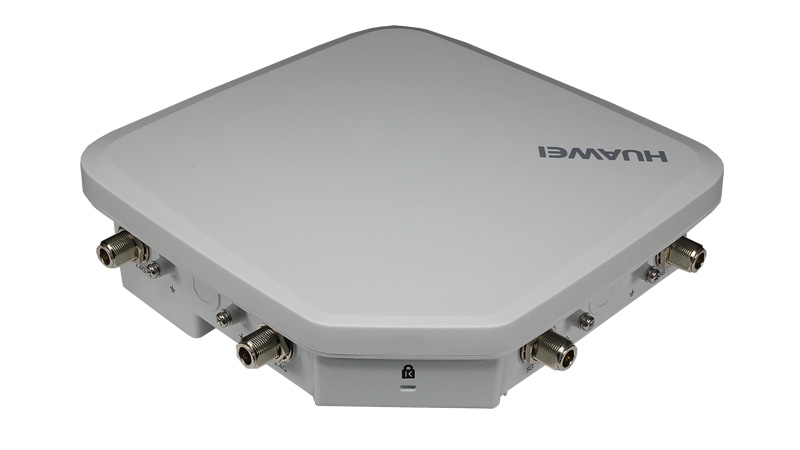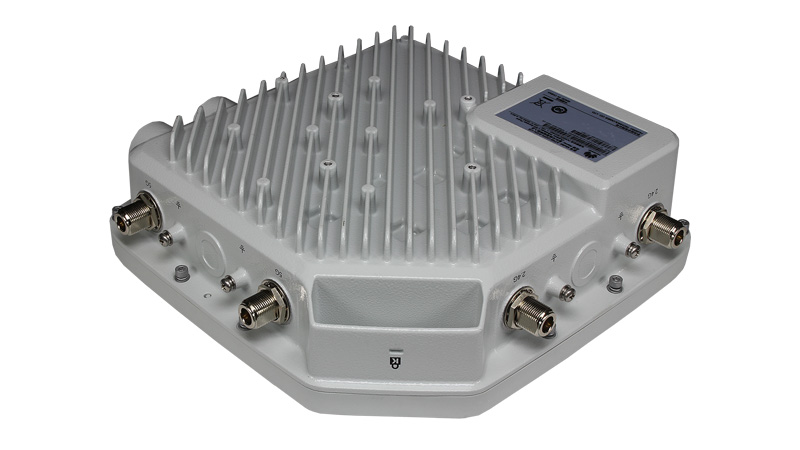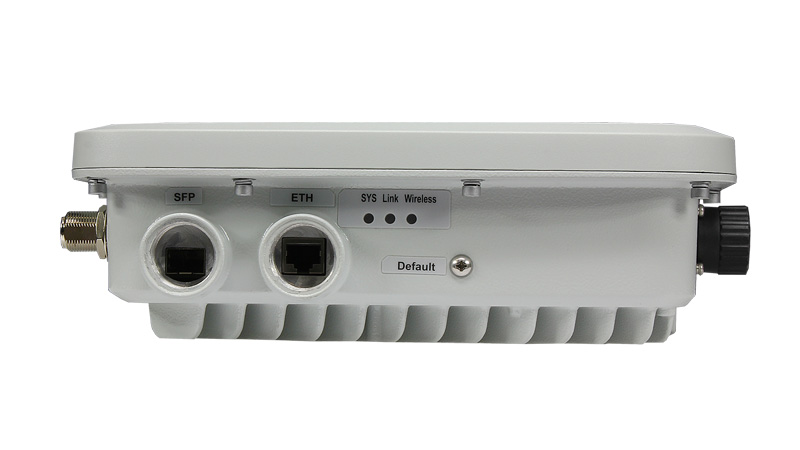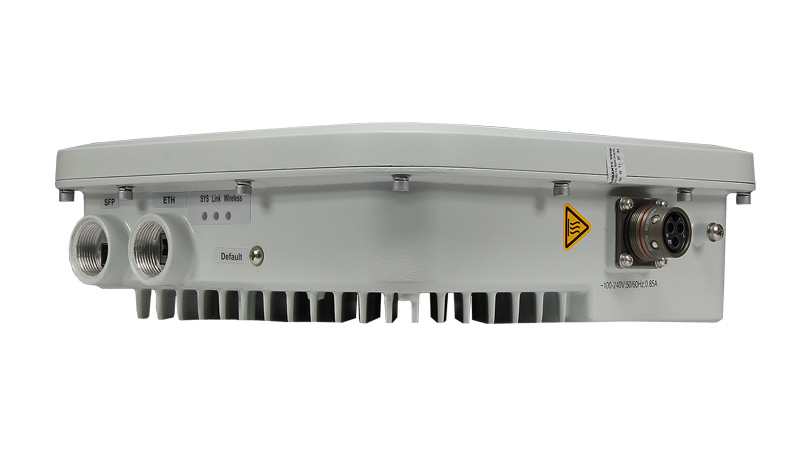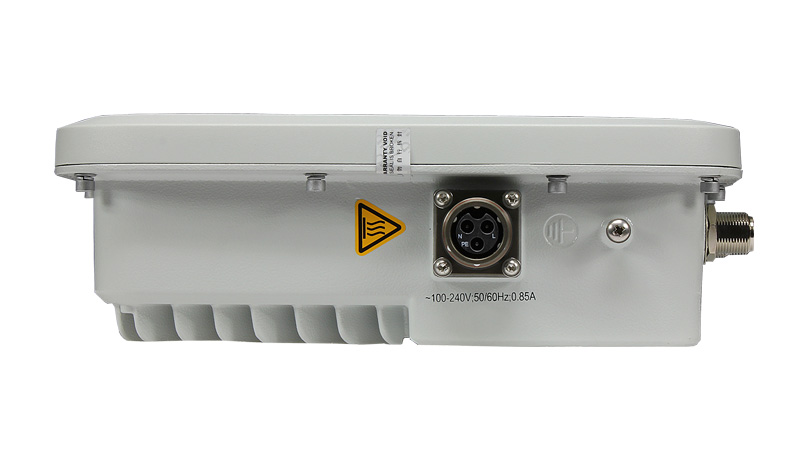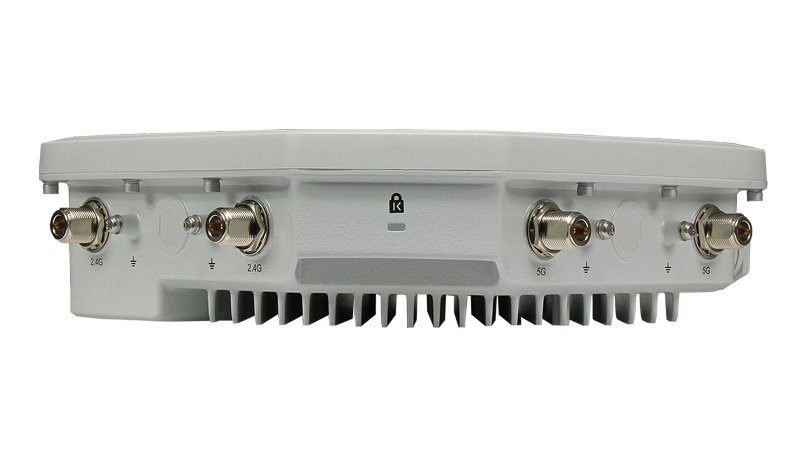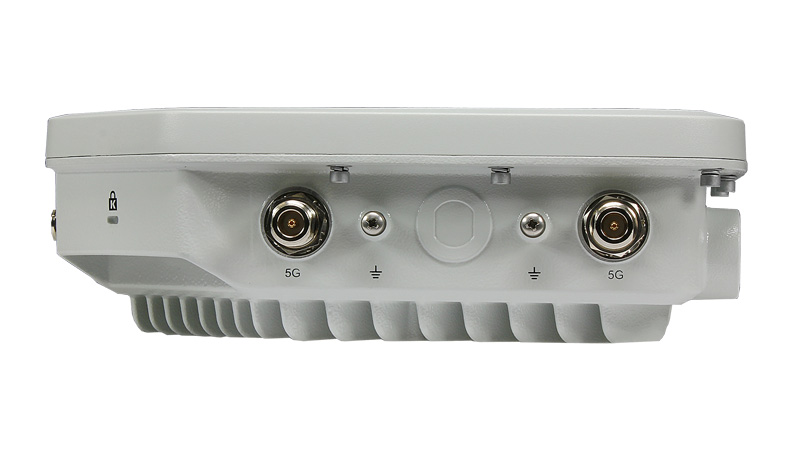Punto de acceso AP6610DN-AGN
El AP6610DN-AGN es una serie mejorada de puntos de acceso (AP) de frecuencia dual. Gracias a su gran nivel de protección física, es aplicable a zonas peatonales, fábricas y otros entornos difíciles. De esta manera, cumple con los requerimientos de implementación de redes en exterior.
Appearance
Ports
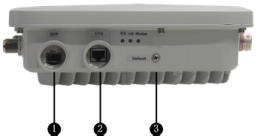
1.SFP: optical port.
2.ETH: 10/100/1000M port, which connects to the Ethernet network.
3.Default button: restores the factory settings if you remove the screw and hold down the button more than 3s from the hole.
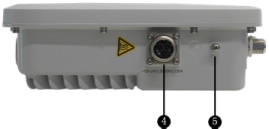
4.Power input interface
5.Ground port: connects to a ground cable to ground an AP.

6. 2.4 GHz antenna port.
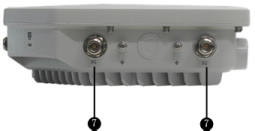
7. 5 GHz antenna port.
LED Indicators
| Information Type | SYS LED | Link LED | WiFi LED | Description |
|---|---|---|---|---|
| Startup status Running and connection status | Steady green | – | – | The system is being initialized. |
| Blinking green | – | – | Memory check, software system, and system initialization are all normal. | |
| Steady red | – | – | Memory check fails or the system software fails to be loaded. | |
| Blinking green once every 2s (0.5 Hz) | Off | Off | The system is running properly, but no Ethernet connection is available. Radios are disabled, and no STA is connected to the AP. | |
| Blinking green | The system is running properly, but no Ethernet connection is available. The AP has STAs connected to the 2.4 GHz band and is transmitting data. The indicator blinks more quickly when more data is being transmitted. | |||
| Blinking yellow | The system is running properly, but no Ethernet connection is available. The AP has STAs connected to the 5 GHz band and is transmitting data. The indicator blinks more quickly when more data is being transmitted. | |||
| Blinking green and yellow alternately | The system is running properly, but no Ethernet connection is available. The AP has STAs connected to the 2.4 GHz and 5 GHz bands. | |||
| Blinking green once every 2s (0.5 Hz) | Steady or blinking green | Off | The system is running properly and the Ethernet connection is normal. Radios are disabled. The indicator blinks more quickly when more data is being transmitted. | |
| Blinking green | The system is running properly and the Ethernet connection is normal. The AP has STAs connected to the 2.4 GHz band and is transmitting data. The indicator blinks more quickly when more data is being transmitted. | |||
| Blinking yellow | The system is running properly and the Ethernet connection is normal. The AP has STAs connected to the 5 GHz band and is transmitting data. The indicator blinks more quickly when more data is being transmitted. | |||
| Blinking green and yellow alternately | The AP has STAs connected to the 2.4 GHz and 5 GHz bands. The indicator blinks more quickly when more data is being transmitted. |
Highly reliable wireless access
- Complies with IEEE 802.11a/b/g/n.
- Supports 2×2 MIMO and provides a maximum rate of 600 Mbit/s.
- Supports Wi-Fi Multimedia (WMM) and priority mapping on the air interface and wired interface.
- Supports wired link integrity check.
- Supports load balancing.
- Supports roaming without service interruption in Fit AP mode.
- Supports AC dual-link backup and VRRP hot backup in Fit AP mode.
- Supports 11n beamforming.
- Uses the latest 802.11n chip to provide higher performance and wider coverage.
- Uses a metal shell and heat dissipation design to ensure high reliability.
Comprehensive user access control capability
- Supports access control lists (ACLs) and implements user access control based on the user group policy.
- Provides fine-grained bandwidth management for each user.
- Supports user isolation policies.
- Supports unified authentication on the AC in Fit AP mode.
- Identifies the device type according to the organizationally unique identifier (OUI) in the MAC address, user agent (UA) information in an HTTP packet, and DHCP options in Fit AP mode.
- The RADIUS server delivers packet forwarding, security, and QoS policies according to the device type carried in the RADIUS authentication and accounting packets in Fit AP mode.
High security
- Open system authentication
- WEP authentication/encryption
- WPA/WPA2-PSK authentication and encryption
- WPA/WPA2-802.1x authentication and encryption
- WAPI authentication and encryption
- Supports wireless intrusion detection system (WIDS), including rogue AP and STA detection, attack detection, STA/AP blacklist and whitelist.
Flexible networking and environment adaptability
- Provides flexible networking capabilities and applies to various application scenarios. Mesh and WDS scenarios are supported only in Fit AP mode.
- Has strong environment adaptability. The AP can automatically select the transmission rates, channels, and transmit power to adapt to various radio environments and avoid interference in real time.
- Adjusts bandwidth allocation based on the user quantity and environment to improve user experience.
- Supports the MIMO antenna system and connects to external dual-band antennas (2.4 GHz and 5 GHz). The antennas can be flexibly adjusted.
- Identifies interference sources such as bluetooth devices, microwave ovens, cordless phones, ZigBees, game controllers, 2.4 GHz/5 GHz wireless video and audio devices, and baby monitors in Fit AP mode and works with eSight to locate interference sources and display spectrums.
Simple device management and maintenance
- Automatically goes online and loads the configuration, and supports plug-and-play (PnP) in Fit AP mode.
- Supports batch upgrade.
- Allows real-time monitoring on the network management system (NMS) to facilitate remote configuration and fast fault location.
- Supports the Link Layer Discovery Protocol (LLDP) to implement automatic link discovery and obtain the network topology.
High reliability and protection level
- Provides strong hardware protection capability.
- Adapts to a wide temperate range from -40°C to +60°C.
- Uses industry-standard components and design methods, improving industry-level reliability.
- Provides IP67 protection level.
- Has a built-in 5 kA feeder surge protector and requires no external surge protective devices, which simplifies installation and lowers costs.
- Provides 6 kA or 6 kV surge protection capability on an Ethernet interface.
- AP6610DN-AGN: provides 20 kA surge protection on an AC power interface, without external AC surge protective devices.
- AP6610DN-AGN: complies with international standards and China safety standards III.
- AP6610DN-AGN: supports uplink optical interfaces, extending the transmission distance.
WLAN features
- Compliance with IEEE 802.11a/b/g/n, providing a maximum rate of 600 Mbit/s
- Maximum ratio combining (MRC)
- Maximum-likelihood detection (MLD)
- Data unit aggregation, including A-MPDU (Tx/Rx) and A-MSDU (Rx only)
- Short GI in 20 MHz and 40 MHz modes
- Priority mapping and packet scheduling based on a Wi-Fi Multimedia (WMM) profile to implement priority-based data processing and forwarding
- Automatic and manual rate adjustment (the rate is adjusted automatically by default)
- WLAN channel management and channel rate adjustment
- Automatic channel scanning and interference avoidance
- Service set identifier (SSID) hiding
- Signal sustain technology (SST)
- Unscheduled automatic power save delivery (U-APSD)
- Control and Provisioning of Wireless Access Points (CAPWAP) in Fit AP mode
- Automatic login in Fit AP mode
- Wireless distribution system (WDS) in Fit AP mode
- Mesh networking in Fit AP mode
Network features
- Compliance with IEEE 802.3u
- Auto-negotiation of the rate and duplex mode and automatic switchover between the Media Dependent Interface (MDI) and Media Dependent Interface Crossover (MDI-X)
- SSID-based VLAN assignment
- VLAN trunk on uplink Ethernet ports
- 4094 VLAN IDs (1-4094) and a maximum of 16 virtual APs (VAPs) for each radio
- AP control channel in tagged and untagged mode
- DHCP client, obtaining IP addresses through DHCP
- Tunnel data forwarding and direct data forwarding
- STA isolation in the same VLAN
- Access control lists (ACLs)
- Link Layer Discovery Protocol (LLDP)
- Uninterrupted service forwarding upon CAPWAP channel disconnection in Fit AP mode
- Unified authentication on the AC in Fit AP mode
- AC dual-link backup and VRRP hot backup in Fit AP mode
- Native IPv6
- IPv4/IPv6 dual stack
- IPv6 Portal
- IPv6 SAVI
- IPv4/IPv6 ACL
QoS features
- Priority mapping and packet scheduling based on a Wi-Fi Multimedia (WMM) profile to implement priority-based data processing and forwarding
- WMM parameter management for each radio
- WMM power saving
- Priority mapping for upstream packets and flow-based mapping for downstream packets
- Queue mapping and scheduling
- User-based bandwidth limiting
- Adaptive bandwidth management (the system dynamically adjusts bandwidth based on the number of users and radio environment to improve user experience)
Security features
- Open system authentication
- WEP authentication/encryption
- WPA/WPA2-PSK authentication and encryption
- WPA/WPA2-802.1x authentication and encryption
- WAPI authentication and encryption
- Supports wireless intrusion detection system (WIDS), including rogue AP and STA detection, attack detection, STA/AP blacklist and whitelist.
- DHCP Snooping
- DAI(Dynamic ARP Inspection)
- IPSG(IP Source Guard)
Maintenance features
- Unified management and maintenance on the AC in Fit AP mode
- Automatic login and configuration loading, and plug-and-play (PnP) in Fit AP mode
- WDS zero-configuration deployment in Fit AP mode
- Mesh network zero-configuration deployment in Fit AP mode
- Batch upgrade
- Local AP management through the serial interface or using Telnet
- Real-time configuration monitoring and fast fault location using the NMS
- System status alarm
- Dying Gasp
BYOD
- Identifies the device type according to the organizationally unique identifier (OUI) in the MAC address.
- Identifies the device type according to the user agent (UA) information in an HTTP packet.
- Identifies the device type according to DHCP options.
- The RADIUS server delivers packet forwarding, security, and QoS policies according to the device type carried in the RADIUS authentication and accounting packets.
Locating Service
- Locates tags manufactured by AeroScout or Ekahau.
- Locates Wi-Fi terminals.
Spectrum Analysis
- Identifies interference sources such as bluetooth devices, microwave ovens, cordless phones, ZigBees, game controllers, 2.4 GHz/5 GHz wireless video and audio devices, and baby monitors.
- Works with eSight to locate and perform spectrum analysis on interference sources.
Specifications
| Item | Description | |
|---|---|---|
| Technical specifications | Dimensions (H×W×D) | 83 mm×255 mm×255 mm |
| Weight | 2.65 kg | |
| System memory | 128 MB DDR2 32 MB flash memory | |
| Power specifications | Power input | AC input voltage Rated voltage: 100 V AC to 240 V AC, 50/60 Hz Maximum voltage range: 90 V AC to 264 V AC, 47 Hz to 63 Hz NOTE:The AP6610DN-AGN cannot receive power from a PoE device. When installing the AP6610DN-AGN, ensure that an AC power source is available near the AP6610DN-AGN. |
| Maximum power consumption | 30 W NOTE:The maximum power consumption depends on local laws. | |
| Environment parameters | Operating temperature | -40℃ to +60℃ |
| Storage temperature | -40℃ to +70℃ | |
| Humidity | 0% to 100% (non-condensing) | |
| Waterproof grade | IP67 | |
| Altitude | –60 m to 4000 m | |
Radio Parameters
| Item | Description | |||
|---|---|---|---|---|
| Antenna type | Dual-polarization antenna or common outdoor antenna | |||
| Maximum number of concurrent users | 128 | |||
| Maximum transmit power | 2.4G: 27dBm 5G: 24dBm You can adjust the transmit power from the maximum transmit power by 20 dB, with a step of 1 dB. NOTE:Actual transmit power depends on local laws and regulations. | |||
| Maximum number of non-overlapping channels |
2.4 GHz 802.11b/g 20MHz: 3 802.11n 20MHz: 3 40MHz: 1 |
5 GHz 802.11a 20MHz: 5 802.11n 20MHz: 5 40MHz: 2 | ||
| NOTE:The number of non-overlapping channels allowed varies in different countries. For details, see the Country codes & Channels compliance status | ||||
| Channel Rate | 802.11b: 1, 2, 5.5, and 11 Mbit/s | |||
| 802.11g: 6, 9, 12, 18, 24, 36, 48, and 54 Mbit/s | ||||
| 802.11n data rate (2.4 GHz and 5 GHz) | ||||
| GI2=800ns | GI=400ns | |||
| 20 MHz (Mbit/s) | 40 MHz (Mbit/s) | 20 MHz (Mbit/s) | 40 MHz (Mbit/s) | |
| 6.5 @ MCS10 | 13.5 @ MCS0 | 7.2 @ MCS0 | 15 @ MCS0 | |
| 13 @ MCS1 | 27 @ MCS1 | 14.4 @ MCS1 | 30 @ MCS1 | |
| 19.5 @ MCS2 | 40.5 @ MCS2 | 21.7 @ MCS2 | 45 @ MCS2 | |
| 26 @ MCS3 | 54 @ MCS3 | 28.9 @ MCS3 | 60 @ MCS3 | |
| 39 @ MCS4 | 81 @ MCS4 | 43.3 @ MCS4 | 90 @ MCS4 | |
| 52 @ MCS5 | 108 @ MCS5 | 57.8 @ MCS5 | 120 @ MCS5 | |
| 58.5 @ MCS6 | 121.5 @ MCS6 | 65 @ MCS6 | 135 @ MCS6 | |
| 65 @ MCS7 | 135 @ MCS7 | 72.2 @ MCS7 | 150 @ MCS7 | |
| 13 @ MCS8 | 27 @ MCS8 | 14.4 @ MCS8 | 30 @ MCS8 | |
| 26 @ MCS9 | 54 @ MCS9 | 28.9 @ MCS9 | 60 @ MCS9 | |
| 39 @ MCS10 | 81 @ MCS10 | 43.3 @ MCS10 | 90 @ MCS10 | |
| 52 @ MCS11 | 108 @ MCS11 | 57.8 @ MCS11 | 120 @ MCS11 | |
| 78 @ MCS12 | 162 @ MCS12 | 86.7 @ MCS12 | 180 @ MCS12 | |
| 104 @ MCS13 | 216 @ MCS13 | 115.6 @ MCS13 | 240 @ MCS13 | |
| 117 @ MCS14 | 243 @ MCS14 | 130 @ MCS14 | 270 @ MCS14 | |
| 130 @ MCS15 | 270 @ MCS15 | 144.4 @ MCS15 | 300 @ MCS15 | |
| NOTE:Modulation coding scheme (MCS) index: determines the spatial flow quantity, modulation, coding rate, and data rate. Guard interval (GI): indicates the period in nanoseconds the radio listens between packets. | ||||
| Receiver Sensitivity |
2.4 GHz 802.11b (CCK) -97 dBm @ 1 Mbit/s -92 dBm @ 2 Mbit/s -92 dBm @ 5.5 Mbit/s -90 dBm @ 11 Mbit/s |
2.4 GHz 802.11g (non-HT20) -92 dBm @ 6 Mbit/s -91 dBm @ 9 Mbit/s -90 dBm @ 12 Mbit/s -87 dBm @ 18 Mbit/s -83 dBm @ 24 Mbit/s -80 dBm @ 36 Mbit/s -76 dBm @ 48 Mbit/s -74 dBm @ 54 Mbit/s |
2.4 GHz 802.11n (HT20) -92 dBm @ MCS0/8 -89 dBm @ MCS1/9 -86 dBm @ MCS2/10 -82 dBm @ MCS3/11 -79 dBm @ MCS4/12 -74 dBm @ MCS5/13 -73 dBm @ MCS6/14 -71 dBm @ MCS7/15 |
2.4 GHz 802.11n (HT40) -89 dBm @ MCS0/8 -86 dBm @ MCS1/9 -83 dBm @ MCS2/10 -79 dBm @ MCS3/11 -76 dBm @ MCS4/12 -72 dBm @ MCS5/13 -70 dBm @ MCS6/14 -68 dBm @ MCS7/15 |
| 5 GHz 802.11a (non-HT20) -90 dBm @ 6 Mbit/s -89 dBm @ 9 Mbit/s -86 dBm @ 12 Mbit/s -84 dBm @ 18 Mbit/s -81 dBm @ 24 Mbit/s -77 dBm @ 36 Mbit/s -72 dBm @ 48 Mbit/s -71 dBm @ 54 Mbit/s |
5 GHz 802.11n (HT20) -84 dBm @ MCS0/8 -81 dBm @ MCS1/9 -79 dBm @ MCS2/10 -76 dBm @ MCS3/11 -72 dBm @ MCS4/12 -68 dBm @ MCS5/13 -67 dBm @ MCS6/14 -67 dBm @ MCS7/15 |
5 GHz 802.11n (HT40) -81 dBm @ MCS0/8 -78 dBm @ MCS1/9 -76 dBm @ MCS2/10 -73 dBm @ MCS3/11 -69 dBm @ MCS4/12 -65 dBm @ MCS5/13 -64 dBm @ MCS6/14 -64 dBm @ MCS7/15 | ||
The AP is applicable to open outdoor areas with high user densities, such as squares, residential communities, schools, and gardens, or outdoor places that have high demands for wireless access, such as pedestrian malls. This AP can be used together with outdoor antenna to provide long-distance network coverage and implements stable radio backhaul in a wireless distribution system.
The AP6610DN-AGN can work as a Fat AP or Fit AP and switch flexibly between the two working modes based on the network plan.
When the wireless network scale is small, customers need to purchase only AP products and set the APs to work as Fat APs. As the network scale expands, tens of or hundreds of APs exist on the network. To simplify network management, customers are advised to purchase ACs to perform centralized management on the APs and set the APs to work as Fit APs.
Fit AP networking (AP mode):
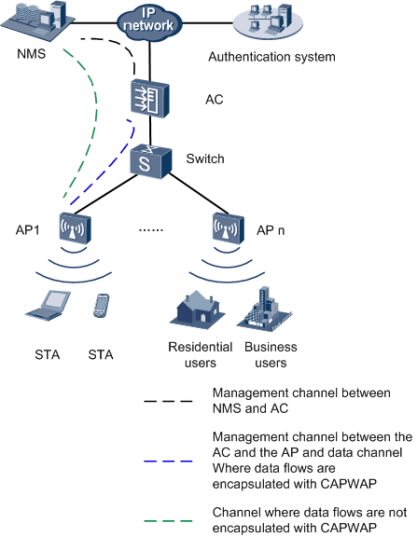
In this networking, the AP functions as a fit AP and provides only data forwarding functions. The AC is responsible for user access, AP go-online, AP management, authentication, routing, security, and QoS.
Fit AP networking (WDS mode: point-to-point):

Fit AP networking (WDS mode: point-to-multipoint):
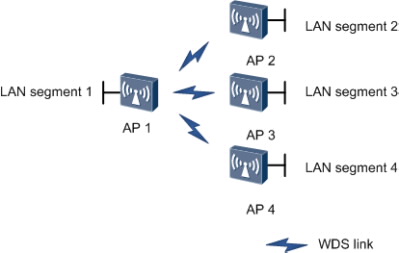
In this networking, the AP connects two or more independently wired or wireless LANs through wireless links to construct a network on which users can exchange data. In Wireless Distribution System (WDS) mode, the AP supports point-to-point (P2P) and point-to-multipoint (P2MP) networking modes. With 5 GHz and 2.4 GHz frequency bands, the AP can implement wireless bridging and access functions.
Fit AP mesh networking:
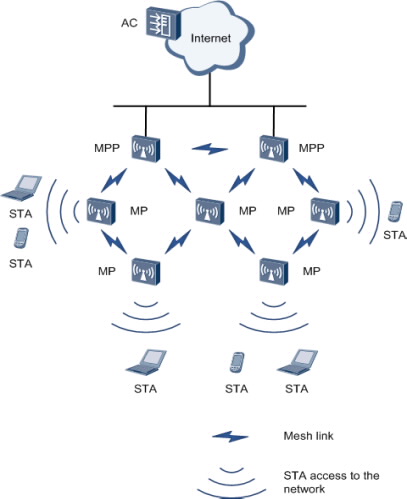
On the preceding network, APs function as mesh points (MPs) and are fully-meshed to establish an auto-configured and self-healing wireless mesh network (WMN). APs with the gateway function can work as the mesh portal points (MPPs) through which the WMN can provide access to the Internet. Terminals connect to APs to access the WMN. The WMN uses dedicated mesh routing protocols to guarantee high transmission quality and is more applicable to scenarios that require high bandwidth and highly stable Internet connections.
Fat AP networking:
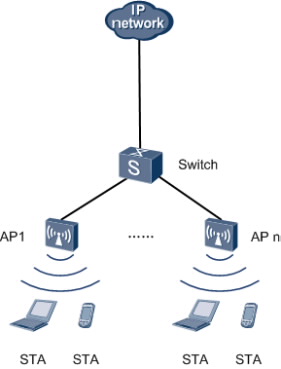
On the preceding network, the device functions as a Fat AP to implement functions such as user access, authentication, data security, service forwarding, and QoS.



